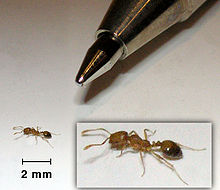- Monomorium
-
Monomorium 
Monomorium pharaonis, and the tip of a pen for scale comparison Scientific classification Kingdom: Animalia Phylum: Arthropoda Class: Insecta Order: Hymenoptera Family: Formicidae Subfamily: Myrmicinae Tribe: Solenopsidini Genus: Monomorium
Mayr, 1855Type species Monomorium monomorium
Bolton, 1987Species see text.
Diversity c. 360 species Synonyms Antichthonidris
Chelaner
Epelysidris
Nothidris
Phacota
Syllophopsis
othersMonomorium is one of the most species-rich genera of ants, with about 300 species. The most famous is the pharaoh ant, which can be a considerable pest, especially in hospitals. Although most are Old World species, mostly from the African tropics, others are found around the globe.
Contents
Description
While the worker caste is monomorphic in some species, in others it is polymorphic. In some species the workers are minute, in others they are rather large. Large, multifaceted eyes are common, but M. inusuale has much reduced eyes, as do some species from Africa. The sting is always functional.[1]
Taxonomy
This large genus was further expanded in 2007[1], when the genera Nothidris, Epelysidris and Phacota (with its single species P. sichelii Roger, 1862) were synonymized with Monomorium. P. sichelii was possibly erroneously based on a wingless queen. The small genera Anillomyrma, Megalomyrmex and perhaps Bondroita should possibly also be included in Monomorium.
The exact boundaries of the genus are yet to be determined. No morphological trait exists that would distinctly separate Monomorium from other genera in the tribe Solenopsidini. If cladistics were strictly applied, all Solenopsidini would have to grouped under one genus (which would be Solenopsis). But even the Solenopsidini lack a strong synapomorphy. Monomorium as it currently stands is paraphyletic, but can be justified on practical grounds as a provisional arrangement. Similar problems are found in the genera Camponotus and Leptothorax.[2]
Distribution
36 species are described from Madagascar, 19 of these were described in 2006 alone; 43 species are known from Australia, 30 from Arabia.[2]
Selected species
- Monomorium antarcticum
- Monomorium bidentatum
- Monomorium chinense
- Monomorium delabiei Fernández, 2007
- Monomorium dentatum
- Monomorium denticulatum
- Monomorium effractor
- Monomorium fieldi
- Monomorium hospitum
- Monomorium inquilinum
- Monomorium inusuale Fernández, 2007
- Monomorium minimum – Little black ant Buckley, 1866
- Monomorium monomorium Bolton, 1987
- Monomorium noualhieri
- Monomorium pergandei
- Monomorium pharaonis – Pharaoh Ant
- Monomorium santschii
- Monomorium smithi
- Monomorium talbotae
Footnotes
References
- Heterick, Brian (2006): A Revision of the Malagasy Ants Belonging to Genus Monomorium Mayr, 1855 (Hymenoptera: Formicidae). Proceedings of the California Academy of Sciences 57(3): 69-202. PDF
- Fernández, F. (2007): Two new South American species of Monomorium Mayr with taxonomic notes on the genus. In: Snelling, R. R., B. L. Fisher, and P. S. Ward (eds). Advances in ant systematics (Hymenoptera: Formicidae): homage to E. O. Wilson – 50 years of contributions. Memoirs of the American Entomological Institute 80: 128-145. PDF
- Japanese Ant Image Database: Monomorium
Further reading
- Mayr, G. (1855): Formicina austriaca. Beschreibung der bisher im oesterreichischen Kaiserstaate aufgefundenen Ameisen nebst Hinzufuegung jener in Deutschland, in der Schweiz und in Italien vorkommenden Ameisen. Verhandlungen des Zoologisch-Botanischen Vereins in Wien 5: 273-478.

This ant-related article is a stub. You can help Wikipedia by expanding it.
